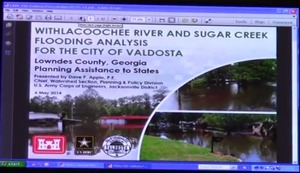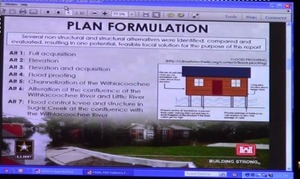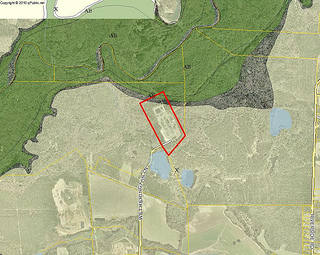 In these videos of
the initial flooding study
by the U.S. Army Corps of Engineers at the Valdosta City Council Work Session,
you can see they’re the Corps, all right: they want to build a levee.
They did emphasize that this was just an initial study on
what could be done inside Valdosta, and their main conclusion
was that there was enough need to indicate federal interest,
as in possibilities of getting federal funding for solutions.
City Manager Larry Hanson got the Corps to confirm (several times)
that Valdosta alone couldn’t stop the flooding, since the vast
majority of floodwaters comes from upstream
on the Withlacoochee and Little Rivers.
In these videos of
the initial flooding study
by the U.S. Army Corps of Engineers at the Valdosta City Council Work Session,
you can see they’re the Corps, all right: they want to build a levee.
They did emphasize that this was just an initial study on
what could be done inside Valdosta, and their main conclusion
was that there was enough need to indicate federal interest,
as in possibilities of getting federal funding for solutions.
City Manager Larry Hanson got the Corps to confirm (several times)
that Valdosta alone couldn’t stop the flooding, since the vast
majority of floodwaters comes from upstream
on the Withlacoochee and Little Rivers.
 Later that same evening in response to citizen questions
at the Valdosta City Hall Annex, the Corps clarified more that
they did understand there were issues of impervious surfaces
and development and loss of wetlands and they wanted to
do a much larger study of the entire watershed,
which could take several years to accomplish.
They kept emphasizing that the Suwannee River watershed
is one of the largest in the country, and there are also
flooding problems on the Suwannee River, which could be important
for obtaining federal dollars.
Later that same evening in response to citizen questions
at the Valdosta City Hall Annex, the Corps clarified more that
they did understand there were issues of impervious surfaces
and development and loss of wetlands and they wanted to
do a much larger study of the entire watershed,
which could take several years to accomplish.
They kept emphasizing that the Suwannee River watershed
is one of the largest in the country, and there are also
flooding problems on the Suwannee River, which could be important
for obtaining federal dollars.
As we already knew, Valdosta has funded projects already started
to move the Withlacoochee Wastewater Treatment Plant (WWTP) uphill
and to add a force main to prevent manhole overflows.
People
downstream in Florida may be relieved to hear something is being done.
Here’s
a video playlist, followed by images of the Corp’s slides and of the City Council, and some notes.
Continue reading →
City Ahead of Schedule on Sanitary Sewer Collection System Improvement Projects









